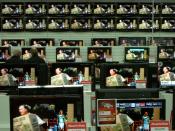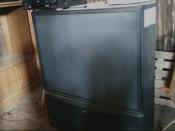It's Sociological Impact from the 1960's to 1990's The programs that we watch on television have had a major sociological impact on us particularly from the 1960's to the 1990's. However this programming would have had little impact on us without the continued development of the television receiver and it's associated peripherals and technology developments.
Television receivers have been called "idiot boxes", "boob tubes", and other less than flattering names. But do these names apply to the device itself or to the programming shown on these devices? In order to understand the impact of these devices, it is best to review a short history of the invention and development of television.
The first television was invented by Philo Farnsworth in 1928. This TV was based on the same technology we utilize today, the cathode ray tube. In 1936, at the New York Worlds Fair, RCA Corporation demonstrated the first commercial broadcast of TV with the remarks of President Franklin Delano Roosevelt at the Worlds Fair opening ceremony.
At that time there were less than 2000 televisions in the broadcast area around the New York metropolitan area, most of those in the hands of RCA executives or wealthy private individuals.
Beginning in 1940, RCA began production of the first commercially available TV receivers, but was forced to halt production in 1942 because the materials used in the manufacturing of TV's were required for the war effort.
With the conclusion of World War II, the production of TV's began again with companies such as RCA, Columbia, Dumont, Crosley and Andrea leading the way. These first "mass produced" TV's had 7 inch screens, a very large speaker and were floor models only general measuring 3.5 feet high by 2.5 feet wide and 3 feet deep. The first TV's generally weighed between 200 and 300 lbs. These new TV's were wildly popular with over 500,000 sold in the first 5 years.
Television networks sprung up to broadcast programming including CBS, and the NBC Blue and Red networks, (the NBC Blue network later was sold and became ABC.
In 1958, RCA introduced the first color televisions in a big screen format (19 inches). This began the age of Television as we know it today. Later developments included remote controls, larger screens, higher resolution, stereo and surround sound, automatic color and tint controls, the introduction of projection TV's and in the 1990's the introduction of HDTV, (High Definition Television).
Surrounding these developments were the invention of many peripherals including VCR's, audio equipment that was designed to interconnect to televisions, satellite receivers and computer type devices that recorded and paused live TV programs by use of a hard drive.
This invention and the devices that are peripheral to it have changed American's lifestyle, the way we perceive others, the way we get news and information and started nationwide trends that began on television.
Following are some of the concepts that we have reviewed and how these concepts have been amended and changed our lifestyles due to the introduction of television receivers.
Having a television in your home has been cool since the advent of the television. In the beginning it was cool to just have a television. By the mid-1960's, TV's were more than a cool thing to have in your home, they were a status symbolâ¦.particularly if they were color TV's.
Over the next 30 years, TV's remained cool as they became feature laden and could do more and more. Both adults and children wanted to watch TV at the homes of friends who had the biggest and clearest screen, the best sound and the best viewing environment Beginning in the late 1980's, the rich initially and then a larger and larger slice of the U.S. population began to install home theatre rooms in their homes. These rooms included projection TV, surround sound and comfort that was similar to private screening rooms. This is the current state of the art in television viewing. Approximately 7% of the homes in the United States currently have home theatre rooms and this is expected to grow to around 15% by 2007. People who have these rooms are considered the ultimate and have become bragging points for those that have them. Also technological advances have made TV cool, such as TV's that are handheld or be built into automobiles. It is not uncommon today to see people in airports or at sporting events utilizing handheld televisions.
TV's were not considered beautiful for the longest time following their introduction. Rather, purchasers looked at these devices as an extra piece of furniture that they had to find a location for. Manufacturers attempted to make these large blocky beasts look better, but little was accomplished until 1962. In 1962, Philco Electronics introduced the Sculptura.
The Philco Sculptura was the first "good looking" TV the Sculptura was the first tabletop set It had a small base with the tuner, speaker, controls and electronics in them. Sitting on top of this base was a single swivel arm that held the viewing screen housed in a silver or gold case that was sculpted to match the shape of the picture tube. These TV's were so much in demand that Philco could not keep up with demand and the TV had a problem with overheating. They did however, change the way American's looked at this appliance in their home.
Later TV's became shorter in depth and lighter in weight as microchips replaced tubes and mechanical parts. Televisions became the centerpiece of many rooms in American homes because those with state of the art TV's considered them a show piece and thought they were beautiful.
Televisions became points of beauty in a home with custom cabinetry; special finishes and built in cases to hold the television and its associated components. This happened by the mid-1990's Success means many different things to people, but in the majority of America, success is measured by how much you accumulate in material goods. Television receivers are certainly among the items that Americans wish to accumulate.
The original television receivers introduced in the 1940's and 50's cost between $700 and $1200. They were very labor intensive to build and had expensive components inside. As televisions entered the 1960's, prices began to fall and opening the world of television to the masses. Color televisions introduced in the 1960's, cost in the neighborhood of $1200 to $1800 for the early color models.
Today, large screen (27 inch) TV's can be bought almost anywhere and models begin as low as $200 and can extend to $700 for those with all the bells and whistles.
People often purchase a TV today not upon need, but upon the fact that they want the newest, latest and greatest, such as High Definition TV, (HDTV) and Projection TV. These sets are often purchased on the fact that they are status symbols, which often translate into the concept of success. The successful American is often the early adaptor of new television as well as the "Technologically Advanced Family" (TAFI), and both groups generally use their TV's as status symbols. They are the groups that often invite other over to their homes to watch special event broadcasts such as the Super Bowl, Academy Awards and special news events. For these individuals it is an opportunity to show off their success or their new technology which often equates with success.
The concept of home changed markedly from the 1960's to the 1990's, defining what rooms were included in a home and what rooms are no longer required. In the 1960's a home was considered to comprise the following: ÷ living room ÷ dining room ÷ kitchen ÷ den or family room ÷ 3 bedrooms ÷ 2 baths ÷ garage Today's home most likely contains: ÷ Great room ÷ dining room ÷ large eat-in kitchen ÷ 3-4 bedrooms ÷ 2 ý to 3 ý baths ÷ study or computer/home office room ÷ garage While much of the change is attributable to our busy lifestyles and changing of entertainment patterns from formal to casual, a good deal of this is attributed to the television and other home electronics. It is not unusual to have a television in most every room including bedrooms, kitchen, great room, study/home office and in some instances the, one or more bathrooms.
With the increasingly casual lifestyle, also come changes in the layout of homes so that the great room becomes the center of the house, immediately adjacent to the kitchen. This great room most often includes a large screen TV so that family members and guests can entertain themselves while dining or between meals and evenings.
The television has also made a contribution to the way families spend their time together. Because of the number of televisions in each American home, people do not congregate in one room together as they did during the age of radio or the early days of TV. There are so many different programming choices today, that family members will often migrate to their own space, bedroom, great room/den or kitchen to view their own selection. Even the advent of video recording devices has done little to move the family back into one room. Therefore, not only has the TV changed the complexion of the home, it has changed the living habits of those occupying the home.
In conclusion, the television receiver has had pronounce sociological impact on everyday American life in the 30 year period from the 1960's to the 1990's. It has changed our concept of home, family, success and even beauty. This will be an enduring impact for at least as long as until the next great technological breakthrough becomes apparent. Which could be holographic images in the house, time travel or many other possible things.





